I had to go back to St Clair. There were historic tidbits I’d come across when researching my post on the endangered piles but had to put aside for the sake of brevity. And since the Second Beach track had recently reopened there was an opportunity to revisit my 2015 adventure, and see if the skills I’d learned over the last 4 years might help to shed light on the mysterious ruin there.
The first object of my attention upon approaching the Esplanade was the “shark warning bell”. Surely this is a tongue-in-cheek piece of fun, right? Because since when have sharks haunted our cold Dunedin coastline?

Since the 1960s, it turns out.
Which is when three people were killed by sharks in Dunedin waters. Leslie Jordan, a 19 year old student out for a morning surf, was the first victim in 1964. Then 21 year old William Black was claimed during a lifesaving competition at St Kilda in 1967. Third was 23 year old Graeme Hitt, spear fishing off Aramoana mole in 1968. Though there were no more fatalities, there were two further attacks . 17 year old Gary Barton was knocked about by a shark later in 1968 while surfing at St Clair, but luckily escaped serious injury. Barry Watkins, wagging school one day to surf with some mates, was attacked in 1971. The shark injured his leg and snapped his surf board in half.
So yes, the shark bell used to be very serious business indeed. Misty days were known as “sharky days” and swimmers avoided the water at these times.
There have been no shark attacks since 1971, though the shark net installed in 1969 was removed in 2011 so it’s possible Dunedin’s own Jaws is ripe for a return.
Luckily, this fine sunny day was far from a “sharky day”, but just in case I decided that I would not go down to the sands, but instead turn right to follow the Esplanade.
I was looking for the site of “the Pavilion”, a grandiose tea room and change facility installed in 1912 for the convenience of seaside revellers.

It was contentious in its time, with some calling it a gigantic waste of city money and others claiming it would pay for itself by attracting increased visitors to St Clair. There were a few odd structural choices, such as the second story balcony band stand which lacked any sort of access, necessitating the jury-rigging of a window as a makeshift door.
While some grand dances were held on the ground floor, the Pavilion was short lived. It burned down on May 5, 1915 after a May Day celebration. It was replaced by a ground-level band rotunda and toilet facilities, which were torn down in 1953 due to disrepair. Proposals to re-use the site included an ice skating rink, then a tavern, then later a hotel, but the end result is much less exciting.
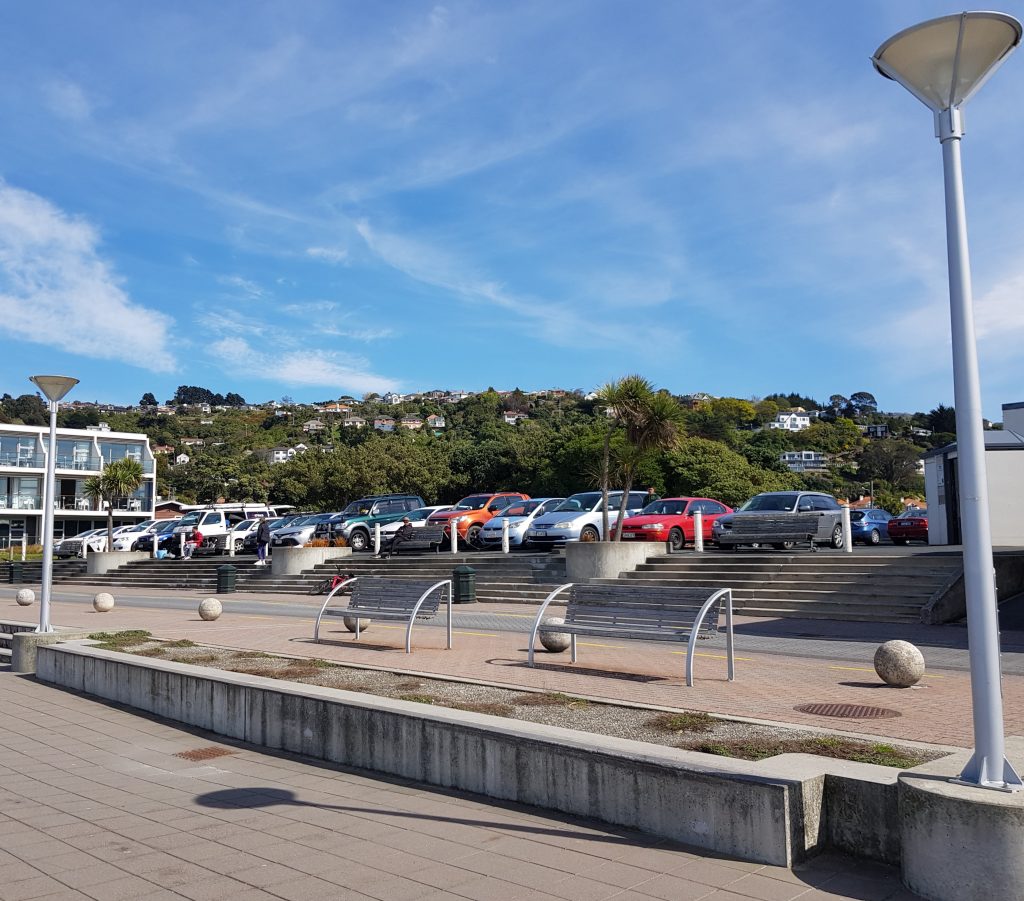
Continuing down the Esplanade, I headed for what I presumed to be Frances Petre’s historic-listed house on Cliff St. Only when I reached the corner I noticed a very similar-looking place down the street. Later when I hit the internet to clarify, I would discover that there are two historic-listed Petre houses on this street, and this one is known as Pinner House.
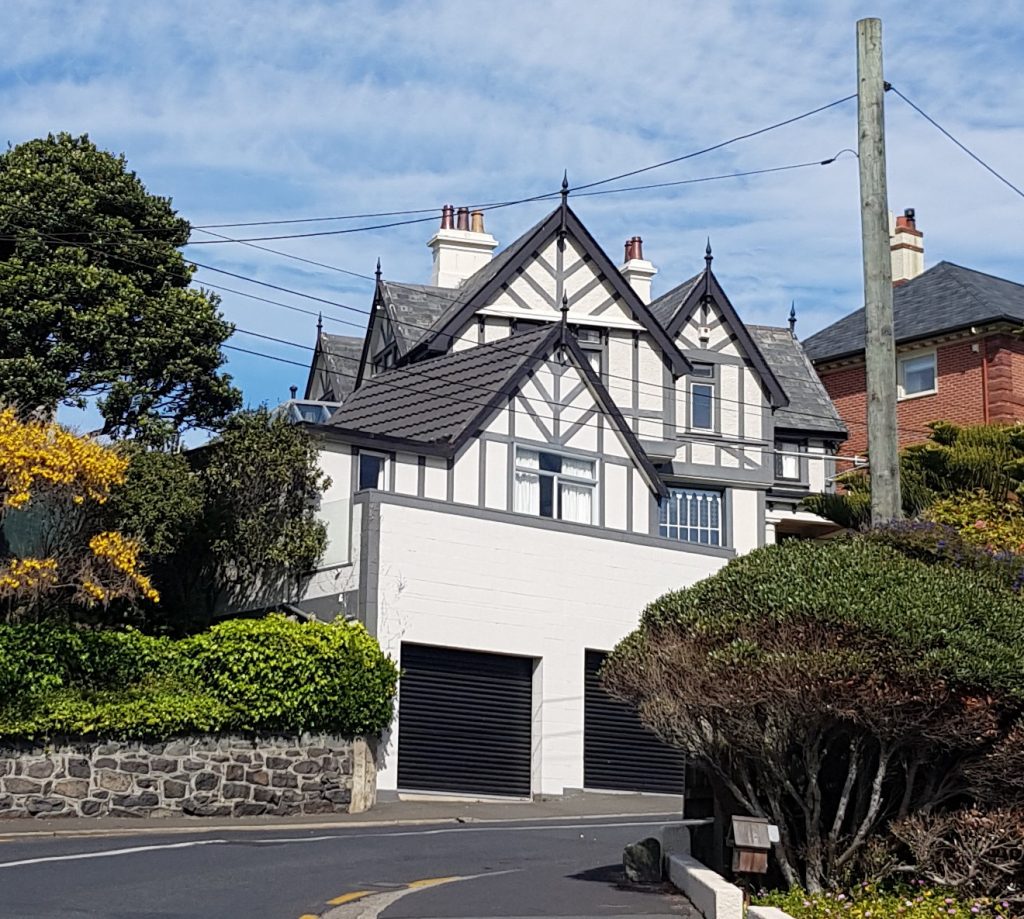
I may have photographed the wrong building, but at least it was built by the right person. Frances Petre built this place in the 1880s for George Aufrere Fenwick, a stockbroker who was one of the founding members of Dunedin’s first stock exchange. His wife Edith Louisa (née Robinson) appears to have been quite the socialite, hosting regular tea parties in her home and even one at the Pavilion during its brief existence.
It appears the couple (whose only child, a daughter, died at the age of 16) called their home “Fairy Hill” – though descriptions of this Cliffs Road property as “double-brick, Georgian style” have me confused all over, for they match the house next door much better.
The Pinner name was given by later owners in the 1970s, after a village in England known for similar Tudor-style architecture.
Better move on before I get too bogged down. I approached the St Clair Hot Salt Water Pool, pretty in duck egg blue.

Opened in 1884, this is believed to be the oldest public facility in Dunedin. To begin with, separate bathing hours were kept for each gender, men generally getting the early morning and evening while women got the middle of the day. This was not always a happy arrangement, as demonstrated by a slew of letters to local papers, too much fun not to quote here.
“A Bashful Bather”, 1884:
A great deal is said just now about indecency at St.Clair, and the unfortunate lords of creation are told they ought to be ashamed of their scandalous behaviour…I belong to the male persuasion, and frequently I bathe. Perhaps you will call me ungallant, and the softer sex may dub me brute; but I cannot help asserting that the scandalous behaviour doesn’t all proceed from our side of the house. The ladies are really most unblushing occasionally. Over the St.Clair baths there is a high bank; the pool is directly below; and it is no uncommon thing to see a bevy of ladies (generally more or less elderly) viewing the evolutions of the males in the water with apparent interest and delight.
“Housewife”, 1886:
As some female correspondents in your columns are asking that the baths should be open whole days to ladies, I beg to protest against anything of the kind…I cannot find much time for outdoor bathing and lounging about the baths myself, and if these female agitators attended to their household affairs properly I don’t think they could have the time either…
“Mother”, 1888:
I wish to bring under the notice of the proper authorities the disgraceful practice indulged In by lads of about fifteen or sixteen years of age bathing in the St. Clair baths without a shred of clothing and in full view of crowds of women and young girls constantly passing along the upper road. Has immorality reached such a pass in this our fair city that such indecency is allowed to go on unchallenged in the full blaze of day?…Are the minds of our young girls here to to polluted by such sights until sin reaches the climax it has in one of the Northern cities, where, I am told, according to recent statistics there are 500 girls under the age of fourteen years on the streets?
This culminated in a furore in 1889 when a young man was arrested for indecency after drying himself off a little too conspicuously after his swim, resulting in a court case too full of hilarity not to pull some further quotes.
The defence:
If women and girls went past these baths…they went deliberately with the knowledge before them that they must see things going on there, and they were not entitled to any sympathy at all…a woman who would go past baths in order to see men with trunks on would be preciously little shocked if she saw men with trunks off.
The prosecution:
When people went into the baths it was necessary for them to have trunks on.
The defence:
They might wear fig leaves for all I know…I may appeal to your Worship to say whether, in the days that you went bathing, there were such things as bathing trunks;- or whether you went into the water as you were born, and came out of it in the same condition. I never possessed a pair of bathing trunks in my life…
The prosecution:
The case for the prosecution is that he stood there so as to show himself as much as he could…
The defence:
At the most the defendant was careless…exposing something to the view of Sergeant Macdonnell, which he in his wicked mind…the wicked mind natural to a policeman—considered to be an indecent act…
I do enjoy the contrast between the typically prudish Victorians and the (also somewhat typical) men getting offended at being asked to wear pants.

The case was dismissed and things appear to have simmered down after that. Today the gender restrictions are gone, we’ve all agreed to wear pants, and the view from the road to Second Beach is blocked by a high wall. Thus I denied a view of the evolutions of any bathers, male or female.
Now on the road to Second Beach, I passed above the conical storm water outlet, which dates to approximately 1904, and continued toward the looming black headland in the distance. About half way there I met my old foe, the concrete wall of mystery.
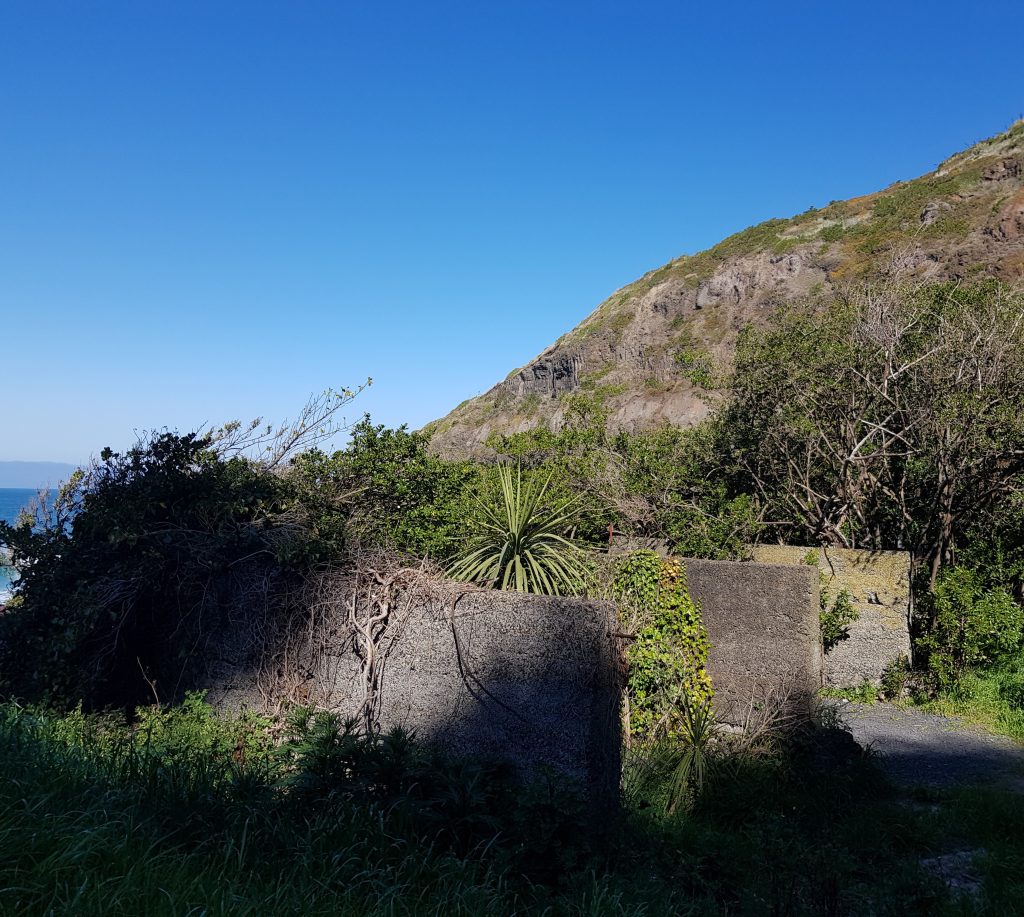
Mystery no longer, I am proud to say! These are what remains of the loading bays of the quarry that operated here from the 1880s, mining the basalt for road metal – much like what’s going on now at Blackhead.
Soon thereafter I made it to the end of the road, where once workmen toiled at the rock face.
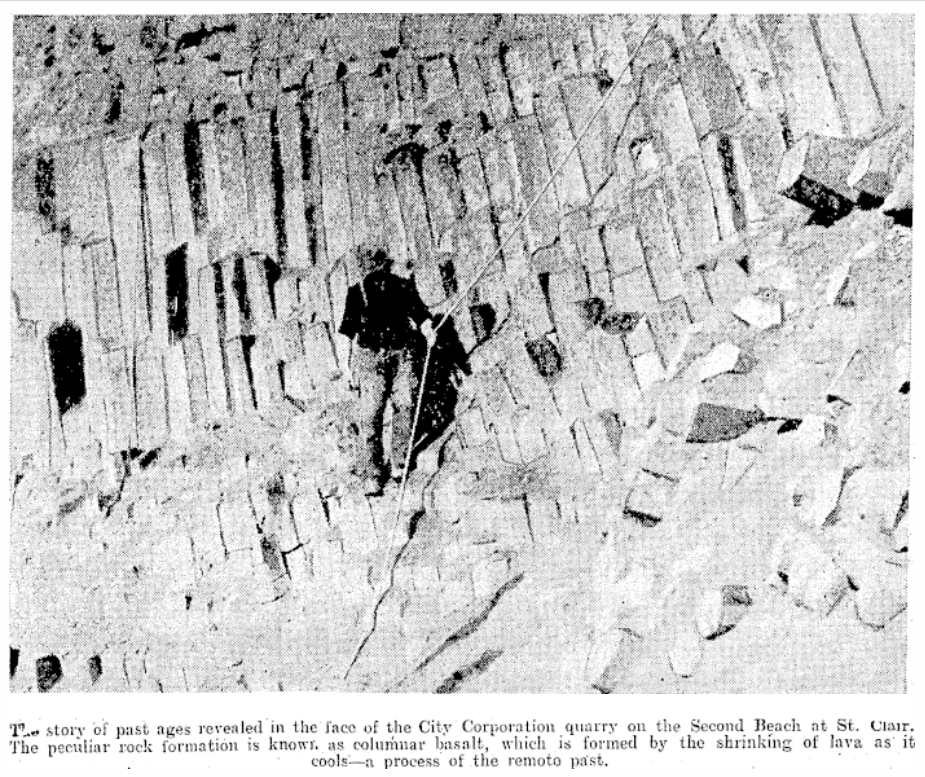
I had walked a mere 800 metres, but that distance was packed with more history than many longer walks. I’d fulfilled my purpose in discovering the use of the old concrete slabs, while dodging shark attacks and challenges to my moral fibre. I’d also discovered a new puzzle in the decoy Petre house.
Who knows, perhaps in another four years I’ll be back with an answer?
References:
Below the Surface by Hamish McNeilly (Part 2, Part 3, Part 4)
Shark attack memories flood back for Dunedin victim’s brother by Hamish McNeilly
Our St Clair : a resident’s history by Barbara A. Newton
OBITUARY Otago Daily Times, Issue 20559, 7 November 1928
TABLE TALK. Otago Witness, Issue 3128, 25 February 1914
Page 14 Advertisements Column 1 Otago Daily Times, Issue 22513, 6 March 1935
BATHERS AND DECENT BEHAVIOUR. Otago Daily Times, Issue 6858, 8 February 1884
ST. CLAIR BATHS. Evening Star, Issue 6867, 2 April 1886
INDECENT BATHERS. Evening Star, Issue 7464, 7 March 1888
ALLEGED INDECENCY AT ST. CLAIR BATHS. Otago Daily Times, Issue 8412, 8 February 1889
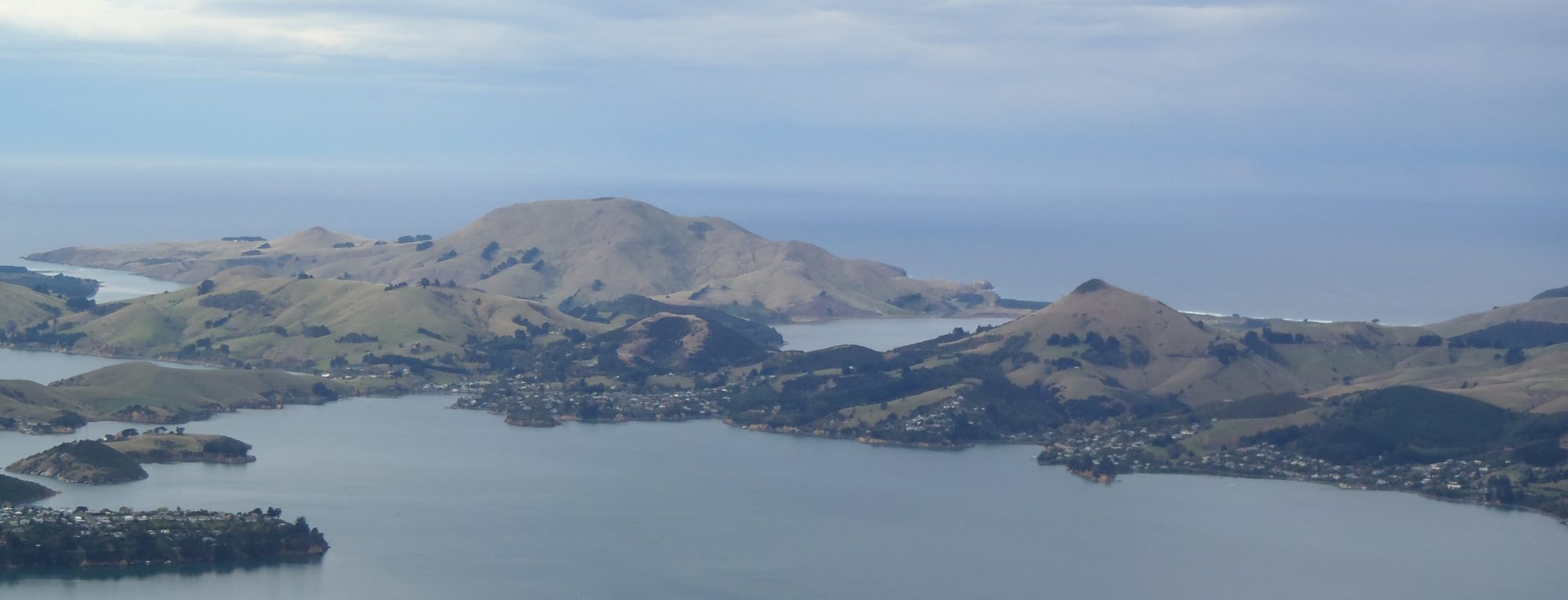



Most people that I have talked to about it are curious why the walls are there so excellent to have some answers. I try and walk my dog around the Second Beach track every day. I count it a bonus when I see the fur seals which can be seen on the rocky beach at the far end, though usually only one or two at a time. It’s a very special place to me so thank you again for your wonderful article/post.